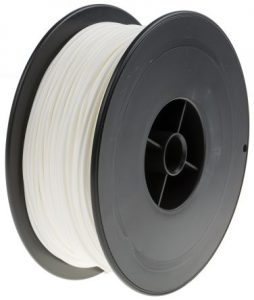One of the most important considerations when buying a 3D printer is the types of filament it can use. By this point, you are likely narrowing down which 3D printer you are going to buy, but exactly what is the difference with the various filaments out there? Let’s take a look and see if we can’t clear some of the murk regarding this essential aspect of 3D printing.
3d printing filaments are the raw materials you will use to create your 3D designs. The filament is inserted into the nozzle of a device, ready for you to make a 3d design!
PLA (Polylactic Acid) and ABS (Acrylonitrile Butadiene Styrene) Filaments
FDM printers require a filament that moves from the spool to the extruder. The Extruder grabs the filament and pushes it into a heating block. This hot end Extruder is equipped with a nozzle on the underside, which allows the melted material to flow through, straight to the print bed, building up the print object layer by layer.
These filaments come in two different diameters, which are 2.85mm and 1.75mm, and they are specific to the type of hot end extruder your 3D printer is equipped with. There’s actually no practical difference between the two sizes. Both of them all gets melted to produce an end product after all, but 1.75mm is the norm, common and inexpensive. Most of the filament spools around will have their recommenced temperature settings provided with them.
PLA (Polylactic Acid) and ABS (Acrylonitrile Butadiene Styrene) are two examples of filament types. The common of the two is PLA, and it works with every FDM printer out there as its build requirements are marginal. PLA is plastic. It is formulated from sugars that are biodegradable and non-toxic, and low in odour, with only a lightly sweet smell when heated. Now for the downside to PLA – it has a high level of surface hardness, which means that it is more brittle than ABS. For this reason, PLA is no good for items that will be put under stress.

ABS needs a higher extrusion temperature, as well as a heated print bed. You’ll likely need to experiment a little to get a consistent level of quality prints. It’s oil-based, so it smells strongly of hot plastic when it is extruded. Have your printer well ventilated when using this filament. ABS filaments are flexible and more durable. They are ideal for prints that are more demanding and need to be hard-wearing; they are also ideal for prints with moving parts.
Other types of filaments
There are other types of filament – composite blends that simulate wood, metal, and some that conduct electricity. They all have their own strengths and weaknesses, as well as different printing requirements. Of course, you’ll have to bear in mind what filaments are compatible with your printer. One of our favourites is the PETG filament, it’s solid and give a glass-like finish on your prints, and it’s even safe for the dishwasher and microwave. Find here an article I have written all about PETG filament. With all this in mind, hopefully, you now have a better understanding of what you need. You’ll likely have a good idea of which filament types will be best for you, which will give you a better idea of what kind of printer will be best suited to you.

